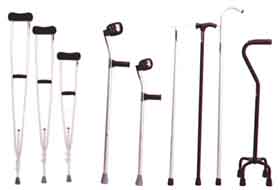How to use crutches, canes and walkers
It is possible that after a fracture, arthroscopy, joint replacement or other surgical procedure need crutches, a cane to a walker.
It is desirable to know how to use them safely and to prepare your home for that is comfortable and safe.
- Remove scatter rugs, electric wires and anything else that gets in the ground and can make you trip.
- In the bathroom, use non-slip mats, grab bars, raised toilet seat and shower seat.
- Simplify your home to have at your fingertips the things you need most.
- Use a backpack or bag that can be hung on a shoulder strap to help carry things. Keep your hands free whenever you can.
Crutches
After an injury or surgery, as arthroscopy or joint replacement, you may need to use crutches.
- Correct position and height
Height crutches: Standing up straight, the top of the crutches should arrive 1 centimeter below the armpits.
The handles of the crutches should be even with the top of the hip line.
Your elbows should bend a little grab handles.
Grasp the top of the crutches tightly against your sides, use your hands to support the weight. The top of the crutches should not clavársele armpits. - Walking with crutches
Lean forward slightly and place the crutches just one step ahead of you. Start over as if to use the injured foot or leg, but instead of supporting foot, support the weight on crutches. Swing your body forward between the crutches. Finish the step normally on the uninjured leg. When you have the uninjured leg on the floor, crutches move forward preparing for the next step. Do not look at your feet but watch where you walk. - To sit
Stand in front of a sturdy chair and stable, turn around. Place the injured foot in front of you and take both crutches in one hand. Use the other hand to feel the chair seat. Slowly lower to the seat. Let crutches leaning backwards in a convenient location, that does not hinder nor could fall. To get up, lean towards the front of the chair. Hold both crutches in the hand on the good leg. Stand up on the good leg. - Stairs
Up and down stairs with crutches, must be strong and flexible at the same time. Stand in front of the stairs, take the railing with one hand and place both crutches under your armpit on the other side. To start up with the good foot, and keeps the injured foot behind you. When lowering, Keep the injured foot in front, and jump into each step with your good foot. Up or down one step each time.
Ask for help, at least initially. If there is no stair railing, up or down with crutches put your good foot jumping a step each time, will have to use more force
Cane
If you have trouble maintaining balance, or weakness in the leg, injury, o dolor, use a cane can help.
- The correct position
Standing up straight, the top of the cane should reach out to the crease of the wrist. The elbow should be flexed slightly while leaning on his cane. Hold the cane in the hand opposite the side that needs support. - Walking with cane
Walking, the cane and your injured leg rest on the ground at the same time. To begin to walk, place his stick step up and start walking on the injured leg. Complete step on his good leg. - Stairs
Climbing stairs, hold on to the railing (if possible) and climb a step on his good leg first, with cane in the hand opposite the injured leg. After the injured leg up. To go down stairs, first put the stick on the first step, then the injured leg, and finally the good leg, supporting body weight.
Walkers
After a total knee replacement or hip, may crutches or a cane are not sufficient to help you walk. A walker can provide more stability. The walker allows you to lean on the arms while walking and relieving weight from your legs. Standing up straight, the top of the walker should match the crease of the wrist. Do not rush when using a walker. As you improve your strength and endurance, gradually his legs will bear more weight.
- Walk
Put the walker one step ahead of you, causing the legs of the walker are flush with the ground. With both hands gripping the top of the walker and walk into it, step starting with the injured leg. First put the heel on the floor, then all the flat foot and finally lift the toes off the ground to complete step with your good leg. Do not give up the big steps to reach the front bar of her walker. To rotate, I take small steps. - To sit
To sit, recule until your legs touch the chair. Feel with your hand the seat before sitting. Getting up from the chair, pull yourself up and hold the handle of the walker. Keep the rubber bumpers on the legs of the walker in good condition. - Stairs
Never attempt to ascend or descend stairs or use an escalator with a walker.
Source: AAOS (American Academy of Orthopaedic Surgeons).

